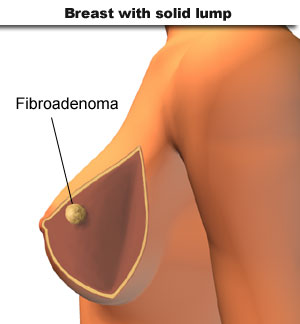Fibroadenoma
Fibroadenoma is the most common benign tumor in the female breast. They generally occur in younger women but can be seen in post-menopausal women as well. Most of the time they present as a lump in the breast, but they can also be found incidentally on a breast radiology exam.
Fibroadenoma is the most common benign tumor in the female breast. They generally occur in younger women but can be seen in post-menopausal women as well. Most of the time they present as a lump in the breast, but they can also be found incidentally on a breast radiology exam.
To a pathologist, a fibroadenoma has two components: the stroma (or "fibro" part), and the breast ductal epithelium (the "adenoma" part). The usual fibroadenoma is benign and does not increase a patient's risk for developing breast cancer. However, the epithelial component can undergo the same changes the rest of the breast epithelium does so that hyperplasia, atypical hyperplasia, and carcinoma can grow within fibroadenomas. When the stroma part of a fibroadenoma changes, then pathologists worry about what is called a phyllodes tumor.
Phyllodes Tumor
This tumor is a much more rare type of tumor than fibroadenoma and they generally are seen in a some what older age group than fibroadenomas. Like fibroadenomas, the tumors are composed of a mixture of stroma and epithelium; however, it is the stroma that distinguishes phyllodes tumors from fibroadenomas.
This tumor is a much more rare type of tumor than fibroadenoma and they generally are seen in a some what older age group than fibroadenomas. Like fibroadenomas, the tumors are composed of a mixture of stroma and epithelium; however, it is the stroma that distinguishes phyllodes tumors from fibroadenomas.
Since these are uncommon tumors in the breast, there are not a lot of large research studies on phyllodes tumors. Generally, pathologists break them down into three different types: benign, border line, and malignant based upon how aggressive the stroma looks under the microscope. All phyllodes tumors, regardless of sub classification, can recur and generally the rate of recurrence increases from benign to borderline to malignant. Most surgeons will try to get a margin of "normal" breast tissue around a phyllodes tumor to reduce the change of the tumor coming back. Phyllodes tumor rarely metastasize and it's usually the malignant variant that does so.
Because these are uncommon tumors, pathologists who don't see a lot of breast pathology may have difficult making the diagnosis. A benign tumor can sometimes be confused with a fibroadenoma, and a more aggressive (malignant) tumor can be confused with a metaplastic carcinoma. Thus, it is important that if there is any question about whether or not you have a typical fibroadenoma or possibly a more aggressive tumor, you should seek a second opinion.
For more information on breast pathology, visit SBPC
2009 Seattle Breast Pathology Consultants, LLC. All rights reserved.
Thomas J. Lawton MD
Article Source: http://EzineArticles.com/?expert=Thomas_Lawton
Article Source: http://EzineArticles.com/3526705
